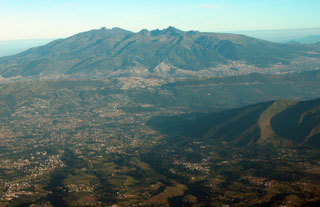Report on Guagua Pichincha (Ecuador) — February 1993
Bulletin of the Global Volcanism Network, vol. 18, no. 2 (February 1993)
Managing Editor: Edward Venzke.
Guagua Pichincha (Ecuador) Phreatic explosion kills two scientists
Please cite this report as:
Global Volcanism Program, 1993. Report on Guagua Pichincha (Ecuador) (Venzke, E., ed.). Bulletin of the Global Volcanism Network, 18:2. Smithsonian Institution. https://doi.org/10.5479/si.GVP.BGVN199302-352020
Guagua Pichincha
Ecuador
0.171°S, 78.598°W; summit elev. 4784 m
All times are local (unless otherwise noted)
A phreatic explosion at 1146 on 12 March in the young crater of Guagua Pichincha's central dome killed two young volcanologists from the Instituto Geofísico. Ing. Victor Hugo Pérez, 31, and Egdo. Alvaro Sánchez, 25, had gone onto the dome, . . . (figure 3), to document recent activity when the strong blast hurled rocks and ash upon them, killing them instantly. Based on seismicity, a warning of possible activity had been transmitted to them by radio at 1030, but for unknown reasons they were still on the dome when the eruption occurred. Search and rescue operations were initiated late that afternoon and at about 0730 the following morning their bodies were discovered by M. Hall near the dome's crater rim.
Guagua Pichincha had been quiet since phreatic activity April-June 1990. The main fumarolic vents on the S side of the dome and the major steam vents at the foot of the S caldera wall exhibited normal fumarolic behavior. Fumarolic activity in the active crater on the NE flank of the dome has been variable but low.
Evidence of recent phreatic activity that had blasted ash and rocks NE against the inner wall of the caldera was noted during routine fieldwork on 11 March. A guard stationed near the caldera rim confirmed that an explosion had occurred on 9 March, depositing up to 10 cm of non-juvenile ash. The Instituto officially advised Civil Defense early on 12 March that Pichincha had resumed dangerous activity and that tourists and mountaineers should be advised of the danger in entering the caldera.
As in past explosive cycles, phreatic activity seems to be related to the rainy season, which normally begins in March. Activity may have begun earlier this year because of the abnormally high rainfall in February.
Geological Summary. Guagua Pichincha and the older Pleistocene Rucu Pichincha stratovolcanoes form a broad volcanic massif that rises immediately W of Ecuador's capital city, Quito. A lava dome grew at the head of a 6-km-wide scarp formed during a late-Pleistocene slope failure ~50,000 years ago. Subsequent late-Pleistocene and Holocene eruptions from the central vent consisted of explosive activity with pyroclastic flows accompanied by periodic growth and destruction of the lava dome. Many minor eruptions have been recorded since the mid-1500's; the largest took place in 1660, when ash fell over a 1,000 km radius and accumulated to 30 cm depth in Quito. Pyroclastic flows and surges also occurred, primarily to then W, and affected agricultural activity.
Information Contacts: M. Hall, Instituto Geofísico de la Escuela Politécnica Nacional.

